Types and selection criteria for lids for pans

When preparing food, you cannot do without a lid that will cover heat-resistant dishes. It will not allow the contents to splash, and will also contribute to the even heating of the ingredients. The lid will be needed during any type of cooking: frying, boiling, stewing, baking. Most pots and pans are sold with lids in advance, but if these dishes are purchased separately, it is important to be responsible when choosing the right lidding product.

Appointment
Products that are cooked under the lid always retain their juiciness and aroma. In addition, this accessory reduces the likelihood of food scorching. For example, the moisture of vegetables does not evaporate from the pan so quickly, but is stored for a long time under the lid and allows the vegetables to be stewed in their own juice. The same can be said for meat. So, supporters of a healthy diet prefer to cook it in a frying pan without oil - it is stewed in broth or vegetable juice and does not burn thanks to the sealed lid.
The product maintains a high temperature, due to which all ingredients are baked well. Besides, the dish is prepared faster, that is, the lid significantly saves the hostess's time.
If the food is fried in oil, then the shelter will save the walls of the kitchen and the stove from greasy splashes that are difficult to clean.

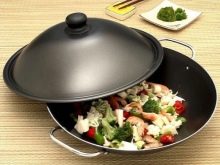
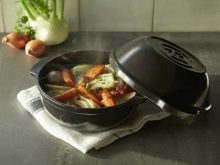
Varieties
Covers for pots and pans may differ in material of manufacture.
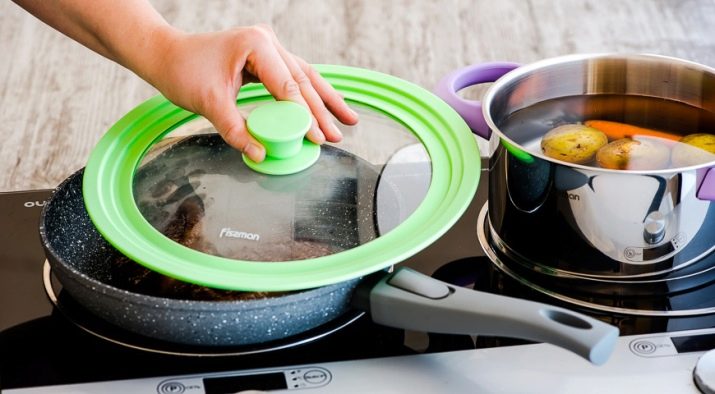
Glass
The most popular option. It can be equipped with a plastic handle or a holder made of other material. This is a handy specimen that allows you to observe the cooking process through the transparent coating.The products under it languish qualitatively, that is, the temperature regime suitable for this process is observed in the vessel.
Such models can be used even when cooking in the oven or microwave, as they are made of heat-resistant glass. It will not be scary to drop such a product, because shock-resistant materials are used in the production. Another advantage of the glass lid is ease of maintenance.
The coating can be easily cleaned from all kinds of dirt, it is not scratched, it is allowed to wash in the dishwasher.
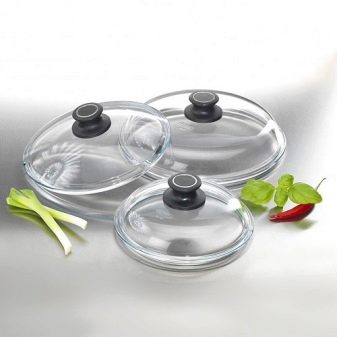

Silicone
Currently, young housewives are just beginning to master modern silicone models, but their advantages have already been noticed. This product can be easily cleaned with any detergent, and it does not heat up during cooking. The accessory fits snugly onto the dishes, ensuring complete tightness. Can be used in an oven. In addition, food can be stored in the refrigerator under a silicone coating. The material from which the cover is made, is food grade silicone and will not harm products.
This product has its drawbacks - it is unstable to scratches.
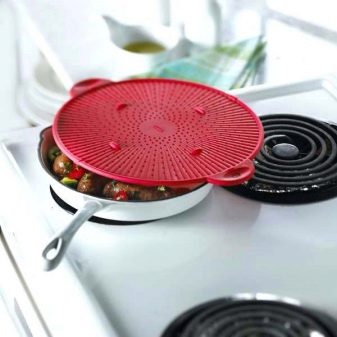
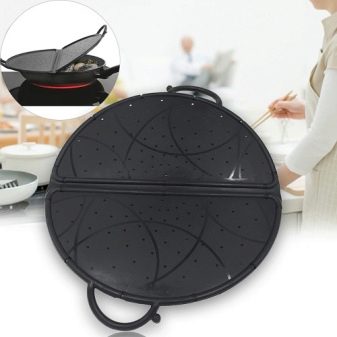
Cast iron
A reliable, durable piece, the quality of which has been tested by time. Cast iron lids were common in Soviet kitchens. And so far this variety has not lost its relevance. Perhaps, the cast iron product can be attributed to the most expensive options, but the price is explained by the almost eternal service life, resistance to damage, functionality.
Among the shortcomings, it is worth noting the heavy weight of cast iron and the possibility of rust formation.
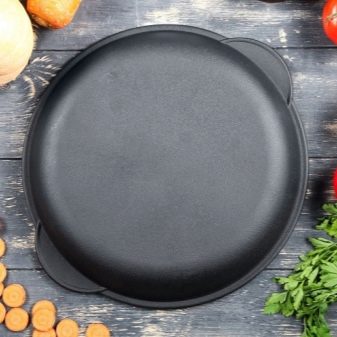

Steel
The lid, made of stainless steel, is highly durable, drop and shock resistant. However, this is not the preferred option. The fact is that such a sample does not retain heat well, and it also cannot be used when cooking in a microwave oven.
In addition, this material is afraid of aggressive chemicals and abrasive agents, so caring for the product is somewhat complicated.
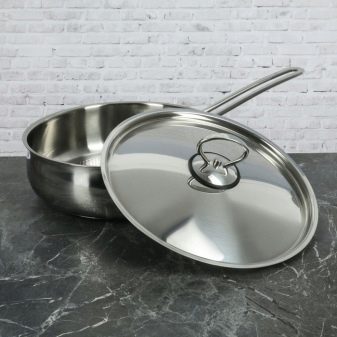
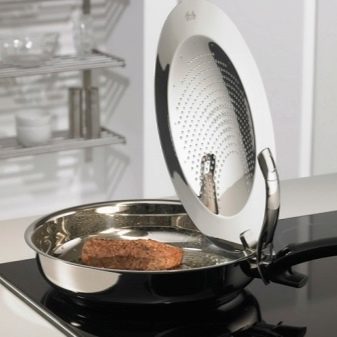
How to choose?
Before choosing a cover, listen to the important guidelines for sizing.
- If you need a lid for a specific pan, then you should study the information about the manufacturer of the dish and find out if he makes lids for this product. A product made specifically for a particular pan model will always work better than another lid.
- To make the lid universal in the kitchen, then select a diameter equal to the diameter of most pans in the house. Ideally, take the dish with you in order to try on the lid on the spot before purchasing, since the diameter of some products does not always correspond to the parameters indicated on the lid.
- If you have no desire to go shopping with a frying pan, then you can measure the diameter of the frying pan in advance. To do this, place a ruler across the center and write down the resulting size from edge to edge. On average, this parameter of dishes is usually limited to 16-32 cm in 2 cm increments, that is, household departments offer models with a diameter of 18, 20, 24, 26, 30 cm.If you need a lid for storing food or heating food in the microwave, then you can pick up covers or caps with odd parameters, for example, 23 or 25 cm.
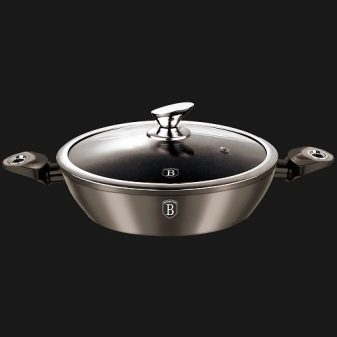
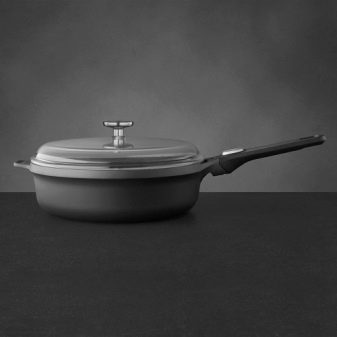
Particular attention should be paid to the shape of the product. The hostess's arsenal should have round, square and rectangular lids. Obviously, each variety is matched to a vessel of a certain shape. Square options designed to retain liquid when using square dishes. Usually these are specimens made of heat-resistant glass, models with a diameter of 28 cm are also often offered for a square grill pan, in which case the lid can be made of cast iron.
A more popular and versatile variety is round cover. As a rule, this is the shape that most pots and pans in the kitchen have.The diameter can be selected in the above ways.
Rectangular products used in the preparation of large portions of fish or meat. When choosing a rectangular lid for a particular dish, it is important to know exactly the length and width, and also try to select a copy of the same manufacturer as the frying pan. Only such a model will provide maximum tightness. Rectangular varieties can be used to store food or keep a finished meal warm.
For example, during the barbecue period, you can take it with you to nature and cover the meat so that it does not cool down.
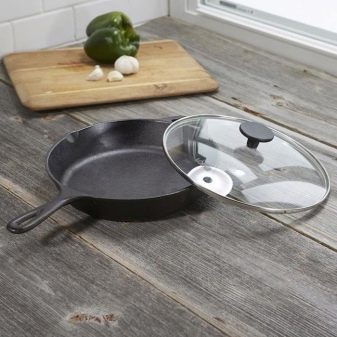

Another important criterion when choosing a cover is handle material. Holders are usually plastic or metal. Most housewives choose products with plastic handles. This option has more pleasant tactile properties, it does not heat up, which means that the hostess does not have to grab the towel every time to lift the lid. Nowadays, most of the models are made with heat-resistant and environmentally friendly plastic handles.
Metal handle - a more stable and durable copy, but it has its drawbacks. Such a holder heats up quickly, and due to its large mass, the weight of such a lid is greater than that of a model with a plastic handle. However, now many manufacturers equip products heat-resistant gaskets in the holder areato avoid overheating.

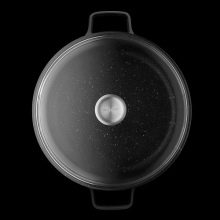
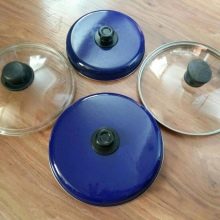
There are a few additional tips for choosing that you should also pay attention to.
- Try to give preference to products with a rubberized rim around the entire perimeter. This will ensure the lid is seated as tightly as possible and will reduce the likelihood of accidental steam burns and grease stains on the stovetop. The rim is especially relevant in the case of choosing a metal cover, since over time, the relief of the coating on this sample can deteriorate, creating a sloppy look.
- If you plan to often stew vegetables under the lid, then choose models with steam holes. During the stewing process, vegetables emit a lot of juice (this is not appropriate for every dish), and if such an accessory is used, steam will be removed through special holes. If the lid you choose is to become universal in the kitchen, then choose a product with steam holes that have closing mechanisms.
- If the lid is needed for cooking at an accelerated pace, it is recommended to select a specimen with a high height. Such models are capable of creating a voluminous thermal cushion, which ensures quick cooking.
- Check how convenient it is to use the copy you like. Make sure it's not too heavy for daily cooking. If the lid is glass, make sure it has a fireproof glass badge.

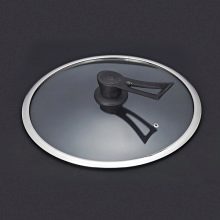
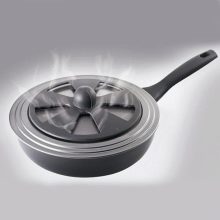
New items
Modern models are offered with additional accessories to make cooking easier. For example, some manufacturers have equipped the lids with special temperature sensors that allow you to control the cooking process and monitor the temperature. However, judging by customer reviews, these sensors quickly break down and clog up, eventually becoming grease and dirt collectors, so it is recommended not to spend money on such models.
Another novelty is splash screen. It may look like a regular lid, but made of fine mesh. The accessory can be used in cases where the dish does not need to create strong steam, for example, when deep roasting meat. Under the classic lid, a ruddy crust will not work, and if you do not use the lid, then the entire stove, walls and the hostess's apron will be splattered with sizzling oil. Just for such cases, a special splash cover is designed.
Buyers note that this attribute makes cooking and cleaning the kitchen much easier.
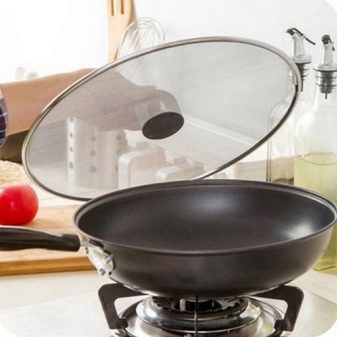
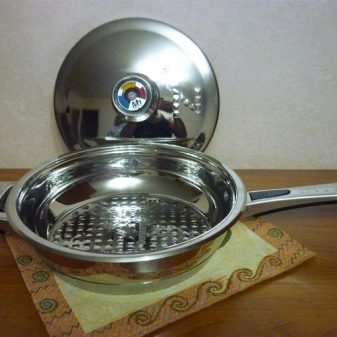
You can learn more about how to properly wash the lid from the frying pan.








